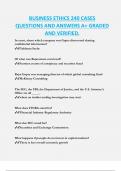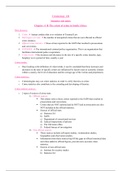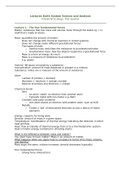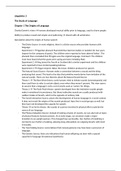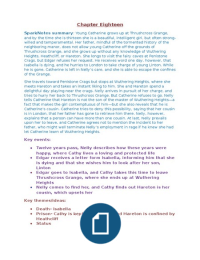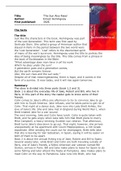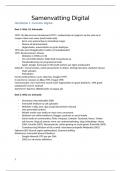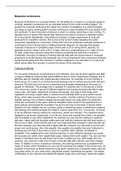Contents
Overzicht Theorieën...................................................................................................................3
1. Introductie............................................................................................................................13
1. Hvistendahl, 2019 – AI outsmarting humanity................................................................13
1. Flora, 2018 – smartphones en tienerbrein........................................................................13
1. Duurzaamnieuws, 2018 – VR maakt milieubewuster......................................................14
1. UN, z.j. – impact of digital technologies..........................................................................14
1. Bond, 2012 – social influence and political mobilization................................................14
2. AI..........................................................................................................................................15
2.1 Wat is AI?.......................................................................................................................15
2.2 Hoe werkt AI?................................................................................................................16
2.3 AI en de maatschappij....................................................................................................17
2. Araujo, 2020 – automated decision making and user perceptions...................................18
2. Gunkel 2012 – reorientation of communication studies..................................................22
3. Tailoring...............................................................................................................................24
3.1 Wat is tailoring?.............................................................................................................24
3.2 Tailoring in de maatschappij..........................................................................................25
3.3 Privacy............................................................................................................................25
3. Debatin, 2009 – Facebook users’ awareness of privacy issues........................................26
3. Kobie, 2019 – social credit system China........................................................................28
4. Social agents.........................................................................................................................28
4.1 Wat zijn social agents?...................................................................................................28
4.2 Chatbots..........................................................................................................................29
4.3 Social robots...................................................................................................................29
4. Nass, 1994 – social rules and computers..........................................................................30
5. VR/AR..................................................................................................................................31
, 5.1 Immersive technologie...................................................................................................31
5.2 Virtual reality.................................................................................................................32
5.3 Augemented Reality.......................................................................................................32
5. Liu, 2003 – head-up display.............................................................................................33
6. Phones and wearables...........................................................................................................35
6.1 Wat is het probleem?......................................................................................................35
6.2 Phone en multitasken......................................................................................................36
6.3 Phone en verslaving en welzijn......................................................................................37
6. The guardian, 2020...........................................................................................................38
6. Ward, 2017 – ever present phone.....................................................................................39
6. Bilieux, 2015 – smartphones as behavioral addiction......................................................42
7. Gaming.................................................................................................................................44
7.1 Belonende technologie: theorie en praktijk....................................................................44
7.2 Serious games.................................................................................................................45
7.3 Into the future.................................................................................................................46
7. Waarloo, 2019 – trucs in spellen......................................................................................46
7. Sicart, 2008 – newsgames................................................................................................48
7. Morganti, 2017 – environmental games...........................................................................50
,Overzicht Theorieën
Theorie Inhoud College
Fear and hype cycles Cycles with positive and negative appreciation 2
(zomers en winters) of AI. A lot of innovations and developments, so
in a hype cycle at the moment.
Framing and Attitudes and perceptions about automated 2
communication of ADM decision making are not only influenced by
technological sollution they offer, or their actual
performance, but also by the way in which these
ADM processes are framed or communicated tot
he user or subject of the decision (Araujo, 2020)
Neutrality of AI Assumption of neutrality and objectivity in AI 2
systems. They are however, created for purposes
that are often far from neutral: to create value
development and capital, to nudge behavior and
structure preferences in a certain way, and to
identify, sort and classify people. Systems are
often carefully and strategically articulated as
impartial and objective socio-technical actors in
discourse surrounding their implementation and
usage in different aspects of daily life. This may
lead to expectations of objectivity and fairness
of a machine (that exceed the level of objectivity
and fairness human decision-makers are capable
of (Araujo, 2020).
Algortihmic appreciation People prefer judgement or recommendations by 2
algorithms when compared to human ones.
Often based on the assumption that statistical
methods outperform human judgement.
Tendency to consider expert systems to be more
objective and rational than a human adviser
(Araujo, 2020).
, Machine heuristic The less a user anthropomorphizes 2
(vermenselijken) an interface, the more she or he
will consider its decisions and selections to be
objective and free of (ideological) biases.
Automated decision making systems might be
perceived as being unbiased and objective,
always applying the same set of rules especially
if its users consider that it is a machine that takes
the decisions (Araujo, 2020).
Computers are social Computers are treated as autonomous sources, 2
actors paradigm with the assumptions or rules decided by the
programmer when creating or managing the
system disappearing from the user’s view, or not
being as prominent in user perceptions (Araujo,
2020).
Less forgiving towards Recognizing that an algorithm makes a mistake 2
ADM – even when its overall performance is better
than of a human – was seen to be sufficient to
make people choose the human decision-maker
an thus leading to algorithmic aversion (Araujo,
2020).
Type of decision-maker Machines were more trusted than human non- 2
experts, but less trusted than human experts
(Araujo, 2020).
Knowledge and attitudes Comfort with mathematics or level of education 2
was shown to generally have better attitudes
towards algorithmic recommendations (Araujo,
2020).
Knowledge and fairness The higher the knowledge of compute 2
programming, the less the algorithmic-mediated
decision was perceived to be fair (Araujo, 2020).
In research of Araujo, knowledge seems to
impact less perceptions of fairness or risk.
Overzicht Theorieën...................................................................................................................3
1. Introductie............................................................................................................................13
1. Hvistendahl, 2019 – AI outsmarting humanity................................................................13
1. Flora, 2018 – smartphones en tienerbrein........................................................................13
1. Duurzaamnieuws, 2018 – VR maakt milieubewuster......................................................14
1. UN, z.j. – impact of digital technologies..........................................................................14
1. Bond, 2012 – social influence and political mobilization................................................14
2. AI..........................................................................................................................................15
2.1 Wat is AI?.......................................................................................................................15
2.2 Hoe werkt AI?................................................................................................................16
2.3 AI en de maatschappij....................................................................................................17
2. Araujo, 2020 – automated decision making and user perceptions...................................18
2. Gunkel 2012 – reorientation of communication studies..................................................22
3. Tailoring...............................................................................................................................24
3.1 Wat is tailoring?.............................................................................................................24
3.2 Tailoring in de maatschappij..........................................................................................25
3.3 Privacy............................................................................................................................25
3. Debatin, 2009 – Facebook users’ awareness of privacy issues........................................26
3. Kobie, 2019 – social credit system China........................................................................28
4. Social agents.........................................................................................................................28
4.1 Wat zijn social agents?...................................................................................................28
4.2 Chatbots..........................................................................................................................29
4.3 Social robots...................................................................................................................29
4. Nass, 1994 – social rules and computers..........................................................................30
5. VR/AR..................................................................................................................................31
, 5.1 Immersive technologie...................................................................................................31
5.2 Virtual reality.................................................................................................................32
5.3 Augemented Reality.......................................................................................................32
5. Liu, 2003 – head-up display.............................................................................................33
6. Phones and wearables...........................................................................................................35
6.1 Wat is het probleem?......................................................................................................35
6.2 Phone en multitasken......................................................................................................36
6.3 Phone en verslaving en welzijn......................................................................................37
6. The guardian, 2020...........................................................................................................38
6. Ward, 2017 – ever present phone.....................................................................................39
6. Bilieux, 2015 – smartphones as behavioral addiction......................................................42
7. Gaming.................................................................................................................................44
7.1 Belonende technologie: theorie en praktijk....................................................................44
7.2 Serious games.................................................................................................................45
7.3 Into the future.................................................................................................................46
7. Waarloo, 2019 – trucs in spellen......................................................................................46
7. Sicart, 2008 – newsgames................................................................................................48
7. Morganti, 2017 – environmental games...........................................................................50
,Overzicht Theorieën
Theorie Inhoud College
Fear and hype cycles Cycles with positive and negative appreciation 2
(zomers en winters) of AI. A lot of innovations and developments, so
in a hype cycle at the moment.
Framing and Attitudes and perceptions about automated 2
communication of ADM decision making are not only influenced by
technological sollution they offer, or their actual
performance, but also by the way in which these
ADM processes are framed or communicated tot
he user or subject of the decision (Araujo, 2020)
Neutrality of AI Assumption of neutrality and objectivity in AI 2
systems. They are however, created for purposes
that are often far from neutral: to create value
development and capital, to nudge behavior and
structure preferences in a certain way, and to
identify, sort and classify people. Systems are
often carefully and strategically articulated as
impartial and objective socio-technical actors in
discourse surrounding their implementation and
usage in different aspects of daily life. This may
lead to expectations of objectivity and fairness
of a machine (that exceed the level of objectivity
and fairness human decision-makers are capable
of (Araujo, 2020).
Algortihmic appreciation People prefer judgement or recommendations by 2
algorithms when compared to human ones.
Often based on the assumption that statistical
methods outperform human judgement.
Tendency to consider expert systems to be more
objective and rational than a human adviser
(Araujo, 2020).
, Machine heuristic The less a user anthropomorphizes 2
(vermenselijken) an interface, the more she or he
will consider its decisions and selections to be
objective and free of (ideological) biases.
Automated decision making systems might be
perceived as being unbiased and objective,
always applying the same set of rules especially
if its users consider that it is a machine that takes
the decisions (Araujo, 2020).
Computers are social Computers are treated as autonomous sources, 2
actors paradigm with the assumptions or rules decided by the
programmer when creating or managing the
system disappearing from the user’s view, or not
being as prominent in user perceptions (Araujo,
2020).
Less forgiving towards Recognizing that an algorithm makes a mistake 2
ADM – even when its overall performance is better
than of a human – was seen to be sufficient to
make people choose the human decision-maker
an thus leading to algorithmic aversion (Araujo,
2020).
Type of decision-maker Machines were more trusted than human non- 2
experts, but less trusted than human experts
(Araujo, 2020).
Knowledge and attitudes Comfort with mathematics or level of education 2
was shown to generally have better attitudes
towards algorithmic recommendations (Araujo,
2020).
Knowledge and fairness The higher the knowledge of compute 2
programming, the less the algorithmic-mediated
decision was perceived to be fair (Araujo, 2020).
In research of Araujo, knowledge seems to
impact less perceptions of fairness or risk.


